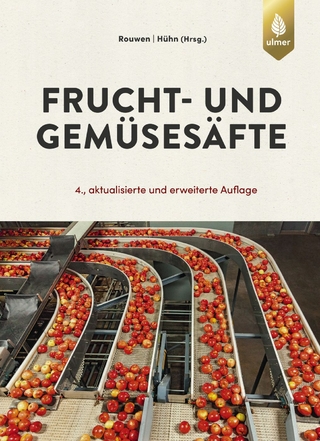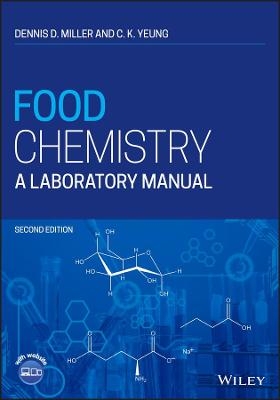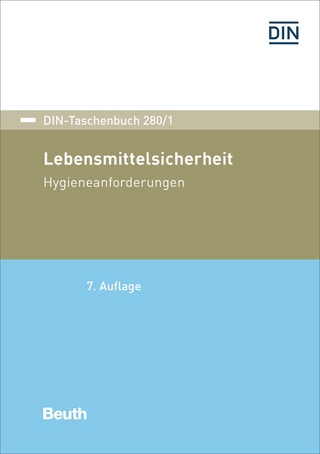
Food Flavorings
Kluwer Academic Publishers (Verlag)
978-0-216-92918-0 (ISBN)
- Titel ist leider vergriffen;
keine Neuauflage - Artikel merken
The flavour industry has become a vital element in the growth and success of food and beverage industries worldwide. The development of many new products is now directly related to the use of the appropriate flavouring which, among other benefits, has allowed the use of many novel raw materials. The phenomenal growth of specialised consumer products offering special tastes, nutritional benefits or 'convenience' almost always directly involves the use of a bespoke flavouring. With recent growth in worldwide concern for environmental issues has come a corresponding concern for the use of 'natural' ingredients in foods. The flavour industry has been closely involved, by offering many of its products as natural alternatives, although the vexed issue of what 'natural' means has promoted discussion and debate in many quarters. The European Flavouring Directive has attempted to incorporate a definition. This is discussed further in chapter 1. The work of the flavourist remains akin to that of the perfumer, despite inroads made by sophisticated analytical technology.
For example, use of linked gas chromatography-mass spectrometry (GC-MS) instrumentation enables the skilled analyst to identify most components of a competitor's flavouring or the minor ingredients of a natural extract. Despite this, the industry remains a unique blend of art, science and technology in which the experience and knowledge of the flavourist is vital.
1 Introduction.- 1.1 General Introduction.- 1.1.1 The U.S. Flavour Industry.- 1.1.2 The U.K. Flavour Industry.- 1.1.3 The European Flavour Industry.- 1.1.4 The Far East Flavour Industry.- 1.1.5 Classification of Flavour Companies.- 1.1.6 Historical Development.- 1.2 Markets.- 1.2.1 Types of Market.- 1.2.2 Market Locations.- 1.2.3 New Entrants.- 1.3 Products.- 1.3.1 Substitute Products.- 1.3.2 Matching Competitors' Products.- 1.3.3 Matching a Natural Product.- 1.4 Emerging Opportunities.- 1.4.1 General.- 1.4.2 Biotechnology.- 1.4.3 Process Flavourings.- 1.4.4 Technological Need.- 1.4.5 Global Aspects of Flavourings.- 1.5 The Future.- 1.6 Legislation.- 1.6.1 United States of America.- 1.6.2 The Europan Scene.- 1.7 The European Flavour Directive.- 1.7.1 Article.- 1.7.2 Article.- 1.7.3 Article.- 1.7.4 Article.- 1.7.5 Article.- 1.7.6 Article.- 1.7.7 Annexes.- 1.8 Council Decision.- 2 Essential Oils.- 2.1 Introduction.- 2.2 The Production of Essential Oils.- 2.2.1 Steam Distillation.- 2.2.2 Water Distillation.- 2.2.3 Other Distillation Methods.- 2.2.4 Expression of oils.- 2.2.5 Extraction.- 2.3 Further Processing of Essential Oils.- 2.3.1 Rectification.- 2.3.2 Washed Oils.- 2.3.3 Oil Quality.- 2.4 The Uses of Essential Oils.- 2.5 The Composition of Essential Oils.- 2.5.1 Bergamot Oil.- 2.5.2 Cassia Oil.- 2.5.3 Cinnamon Oil.- 2.5.4 Clove Oil.- 2.5.5 Coriander Oil.- 2.5.6 Cornmint Oil.- 2.5.7 Dill Oil.- 2.5.8 Eucalyptus Oil.- 2.5.9 Garlic Oil.- 2.5.10 Ginger Oil.- 2.5.11 Grapefruit Oil.- 2.5.12 Lemon Oil.- 2.5.13 Lemongrass Oil.- 2.5.14 Lime Oil.- 2.5.15 Litsea Cubeba Oil.- 2.5.16 Nutmeg Oil.- 2.5.17 Sweet Orange Oil.- 2.5.18 Peppermint Oil.- 2.5.19 Rose Oil.- 2.5.20 Rosemary Oil.- 2.5.21 Spearmint Oil.- 2.5.22 Star Anise Oil.- 2.5.23 Tangerine Oil.- 3 Oleoresins, Tinctures and Extracts.- 3.1 Introduction.- 3.1.1 General Comments.- 3.1.2 Costs.- 3.1.3 Raw Materials and Processes.- 3.2 Plant Materials.- 3.2.1 Origin.- 3.2.2 Crop-to-Crop Variations.- 3.2.3 Storage.- 3.2.4 Yield.- 3.2.5 Degradation.- 3.2.6 Preparation of Plant Material.- 3.2.7 Vanilla Bean Curing.- 3.3 Solvents.- 3.3.1 Polarity.- 3.3.2 Boiling Point.- 3.3.3 Viscosity.- 3.3.4 Latent Heat of Evaporation.- 3.3.5 Temperature/Pressure.- 3.4 Tinctures.- 3.4.1 Water Infusions.- 3.4.2 Alcoholic Tinctures.- 3.5 Oleoresins.- 3.5.1 Solvents.- 3.5.2 Solubility.- 3.5.3 Commercial Solvent Extraction System.- 3.6 Absolutes.- 3.6.1 Solvents.- 3.7 Extraction with Carbon Dioxide as a Solvent.- 3.7.1 Introduction.- 3.7.2 Subcritical CO2.- 3.7.3 Supercritical CO2.- 3.8 Summary.- 4 Fruit Juices.- 4.1 Introduction.- 4.2 Fruit Processing.- 4.2.1 General Considerations.- 4.2.2 Soft Fruit Processing.- 4.3 Specialised Fruit Processing.- 4.3.1 Citrus.- 4.3.2 Comminuted Citrus Bases.- 4.3.3 Pineapple juice.- 4.3.4 Processes Requiring Heat.- 4.4 Products and Packaging.- 4.4.1 Frozen Juices.- 4.4.2 Aseptic Packaging.- 4.4.3 Self-Preserved Juice.- 4.4.4 Preserved Juice.- 4.4.5 Hot Pack Products.- 4.5 Product Specifications.- 4.5.1 Soluble Solids Content.- 4.5.2 Titratable Acidity.- 4.5.3 Brix/Acid Ratio.- 4.5.4 Other Specifications.- 4.5.5 Juice Adulteration.- 4.5.6 Specifications for Essence/Volatiles/Citrus Oils.- 4.6 Volatile Components of Fruit Juices.- 4.6.1 Production.- 4.6.2 Composition of Fruit Juice Volatile Fractions.- 4.7 The Uses of Fruit Juices in Flavourings.- 4.7.1 Fruit Juice Compounds.- 4.7.2 Flavourings.- 4.8 Summary.- 5 Synthetic Ingredients of Food Flavourings.- 5.1 General Aspects.- 5.1.1 Introduction, Definitions and Documentation.- 5.1.2 Flavour Generation.- 5.1.3 Flavour Analysis.- 5.1.4 Flavour Manufacture.- 5.1.5 Composition and Formulation.- 5.2 Synthetic Flavouring Ingredients.- 5.2.1 Classification.- 5.2.2 The Flavour Wheel.- 5.2.3 The Different Flavour Notes.- 5.3 Synthetic Flavour Ingredients and the Future.- 6 Beverage Flavourings and Their Applications.- 6.1 Introduction.- 6.2 Categories of Beverages.- 6.3 Types of Flavourings for Beverages.- 6.4 Methods of Extraction, Solubilisation and Concentration of Flavourings.- 6.4.1 Extraction of Coffee Flavour and Manufacture of the Instant Product.- 6.4.2 Flavourings Extracted from Harvested Fruits.- 6.4.3 Extraction and Use of Oil Soluble Flavourings.- 6.5 Beverages Based on Ginger.- 6.5.1 Manufacture of Ginger Extract.- 6.5.2 Original (Hot) Ginger Ale.- 6.5.3 American or Pale Ginger Ale.- 6.6 Formulation of Beverages.- 6.6.1 General Principles.- 6.6.2 Principal Components used in the Formulation of Beverages.- 6.6.3 Label Claims.- 6.6.4 Sweetness/Acid Ratio.- 6.6.5 Alcoholic Components.- 6.6.6 Water.- 6.6.7 Characterising Ingredients.- 6.6.8 Other Ingredients.- 6.6.9 Acidulants and Acidity Regulators.- 6.7 Summary.- 7 The Flavouring of Confectionery.- 7.1 Introduction.- 7.2 Basic Confectionery Types, Recipes, Inherent Flavours.- 7.2.1 High Boilings.- 7.2.2 Fat Boilings.- 7.2.3 Toffees and Caramels.- 7.2.4 Fudge.- 7.2.5 Fondant.- 7.2.6 Candy.- 7.2.7 Cream and Lozenge Paste.- 7.2.8 Compressed Tablets.- 7.2.9 Jellies and Gums.- 7.2.10 Chewing Gum.- 7.2.11 Panned Work.- 7.2.12 Chocolate.- 7.3 Flavours from Ingredients.- 7.4 Flavours Developed During Processing.- 7.5 Selection of Flavourings.- 8 Flavourings for Bakery and General Use.- 8.1 Ingredients.- 8.1.1 Flour.- 8.1.2 Sugars.- 8.1.3 Fats.- 8.1.4 Liquids.- 8.1.5 Gases.- 8.1.6 Other (Minor) Ingredients.- 8.2 Bakery Products.- 8.2.1 Bread.- 8.2.2 Hot Plate Goods.- 8.2.3 Morning Goods.- 8.2.4 Powder Goods.- 8.2.5 Biscuts.- 8.2.6 Cakes.- 8.2.7 Baking Process.- 8.3 Bakery Fillings.- 8.3.1 Jams and Jellies.- 8.3.2 Marshmallow.- 8.3.3 Creams.- 8.3.4 Biscuit Creams.- 8.3.5 Icings.- 8.4 Summary of Flavouring Characteristics.- 9 Dairy Flavourings.- 9.1 Introduction.- 9.1.1 History of Animal Milks as a Human Food Source.- 9.1.2 The Development of Flavour in Dairy Products.- 9.1.3 Instrumental Analysis.- 9.1.4 The Development and Uses of Dairy Flavourings.- 9.2 Milk and Cream.- 9.2.1 Whole Cows Milk.- 9.2.2 Whole Milk Powder.- 9.2.3 Skimmed Milk.- 9.2.4 Sterilised Milk.- 9.2.5 UHT Milk.- 9.2.6 Evaporated and Sweetened Condensed Milk.- 9.2.7 Cream.- 9.2.8 Sterilised Cream.- 9.2.9 Clotted Cream.- 9.2.10 Casein.- 9.2.11 Whey.- 9.2.12 The Applications of Milk and Cream Flavourings.- 9.2.13 The Development of Milk and Cream Flavourings.- 9.3 Yogurt and Fermented Products.- 9.3.1 Yogurt.- 9.3.2 Other Fermented Milk Products.- 9.4 Butter.- 9.4.1 Sweet Cream Butter.- 9.4.2 Cultured Cream Butter (Lactic Butter).- 9.4.3 Ghee.- 9.4.4 The Flavour of Butter.- 9.4.5 The Uses of Butter Flavourings.- 9.4.6 Margarine and Low-Fat Spreads.- 9.4.7 The Development of Butter Flavourings.- 9.5 Cheese.- 9.5.1 The Manufacture of Cheese.- 9.5.2 Classification of Cheese Types.- 9.5.3 The Development of Flavour in Cheese.- 9.5.4 Review of a Range of Key Cheese Types.- 9.5.5 Related Products.- 9.5.6 Applications of Cheese Flavourings.- 9.5.7 The Development of Cheese Flavourings.- 9.6 Manufacturing Considerations.- 9.7 Conclusion.- 10 Process Flavourings.- 10.1 Introduction.- 10.1.1 Description and Definition.- 10.1.2 History and Necessity.- 10.2 Research into Beef Flavour.- 10.2.1 Reactions of the Precursors.- 10.2.2 Evolved Volatile Compounds.- 10.3 Creating a Process Flavouring.- 10.3.1 Basic or Foundation Part of the Flavouring.- 10.3.2 The Aroma Volatiles.- 10.3.3 Enhancers, Fats, Herbs and Spices.- 10.3.4 Compounding the Complete Process Flavouring.- 10.4 Applications of Process Flavourings.- 10.4.1 Simple Mixing.- 10.4.2 Application to Outside (Dusting).- 10.4.3 Addition During Product Manufacture.- 10.5 The Safety Question.- 10.5.1 Safety of Protein Hydrolysates.- 10.5.2 Safety of Reaction Flavourings.- 10.6 Process Flavourings and the Future.- Appendices.- Appendix I: Composition of Lemon and Orange Oils.- Appendix II: Botanical Classification of Fruits.- Appendix III: I.O.F.I. Guidelines for the Production and Labelling of Process Flavourings.- References.
| Zusatzinfo | biography |
|---|---|
| Verlagsort | Dordrecht |
| Sprache | englisch |
| Maße | 152 x 229 mm |
| Gewicht | 760 g |
| Themenwelt | Technik ► Lebensmitteltechnologie |
| ISBN-10 | 0-216-92918-0 / 0216929180 |
| ISBN-13 | 978-0-216-92918-0 / 9780216929180 |
| Zustand | Neuware |
| Haben Sie eine Frage zum Produkt? |
aus dem Bereich


